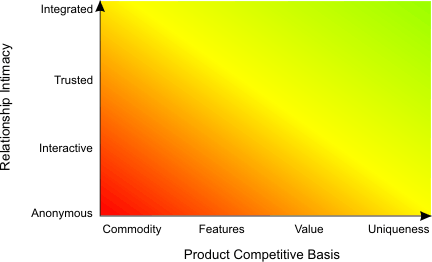
One of our recurring tasks is encouraging clients to expand their innovation horizons. Companies often seem to want to restrict innovation projects to a comparatively narrow scope, which can severely limit their potential. For this reason, I am constantly looking for ways to motivate and visualise the wider range of possibilities that are available.
One such visualisation I call the „Relationship-Competition Space“, which is shown in the figure at the top of the article. This diagram shows a two-dimensional space spanned by the axes Product Competitive Basis and Relationship Intimacy. Each axis covers the range from the worst to the best possible situations to be in with respect to both attaining and retaining customers.
Product Competitive Basis describes the basis on which a product competes in the market. At the bottom of the scale we have Commodities, which – in the customers‘ eyes at least – have no distinguishing features at all, and compete solely on price. At the next level we find Features, which is the most familiar category to most people. Here, products compete on the basis of the features that they provide. PCs, digital cameras and other personal electronics fall into this category. Above this, we have Value. Here a product competes based on the value it provides to the customer. A surprisingly large number of people confuse this category with the previous one. At the top end of the scale we find Uniqueness. In this case, a product uniquely solves a customer’s problem so that, for a certain target market at least, it no longer has any competition at all.
On the vertical scale we have Relationship Intimacy, which describes the depth of the relationship with the customer. At the bottom, we find Anonymity, where the company essentially has no relationship with its customers at all. At the next level we find Interaction, where the company at least succeeds in getting its customers to interact with it in some way. At the third level in this dimension, the company has succeeded in earning the customers‘ trust. Finally it is possible to become integrated with the customer. This means that the product or service is so intimately part of the customer’s life or business, that – exceptional circumstances aside – they would not even consider defecting to a different supplier.
In the case of both dimensions, the lowest end of the scale represents the worst possible situation to be in from a competitive point of view. If a customer cannot tell the difference between your product and your competitor’s, then you are stuck in the commodity trap and are faced with price pressure and zero customer loyalty. Similarly, having no relationship at all with your customers makes it very easy for them to defect to the competition. This is the case, for example, for classical commodities such as gold: if I want to buy gold, I go to a commodities exchange. I will buy the gold that is offered to me for the lowest price and I will never even know in which mine the gold was produced (nor am I interested in finding out).
At the other ends of the two scales, having a product with a unique value proposition or a seamless integration into the customer’s life or business represents the ideal competitive situation, since, in both cases, the customer is very unlikely to switch to a competing offer. To offer a personal example, I only own one pair of shoes. I have bought one pair of these same shoes every year for about 20 years. To me, at least, it is uniquely comfortable, and I have not the slightest inclination to search for an alternative.
When innovating an existing product or service, it makes sense to consider making progress along both dimensions of the diagram rather than just remaining in one location and tweaking the parameters. To limit the interpretation of the question „How can we improve our product?“ to „What features can we add to our product?“, for example, is to ignore several – possibly much more significant – opportunities.
P.S.
For those who are interested, the shoe mentioned in the article is the Model 336 by Jacoform.
